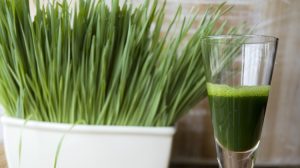11

Wheatgrass
Wheatgrass is the young sprout of the wheat plant, Triticum aestivum. Due to the cellulose in wheatgrass, it must be juiced to make it digestible for humans. One of the interesting things about wheatgrass is that it’s gluten free at the sprout stage of its growth cycle. And oh so healthy!
People have been consuming wheatgrass for over 5000 years, going all the way back to ancient Egypt, and even further to early Mesopotamian civilizations. Even then, wheatgrass was prized for its effects on health and vitality.
It wasn’t until the 1930s that it became popular in the U.S. Then a couple decades later, Ann Wigmore, co-founder of the Hippocrates Health Institute and author, would further popularize the use of wheatgrass, and raw food diets in general.
Wheatgrass is extremely high in chlorophyll, amino acids, antioxidants, enzymes, and more than 70 vitamins and minerals. It can be grown outdoors, indoors, in soil or other growing mediums, or in nothing other than a plastic tray, as Daniela will show you in this video.
Wheatgrass Benefits
Wheatgrass contains an impressive assortment of nutrients, but it’s the chlorophyll content that is perhaps most beneficial. Chlorophyll is the green pigment found in plants, and also considered their lifeblood. Which is appropriate considering that its molecular makeup so closely resembles our own hemoglobin, the protein molecule in red blood cells that transports oxygen from the lungs to the rest of the body.
Chlorophyll helps the body process more oxygen, promotes the growth and repair of tissues and cells, and cleanses the blood. It also alkalizes the body, which is key to reducing the risk of disease, and removes toxins from the body, something that the modern world unfortunately provides an abundance of.
Besides the strong antioxidant properties in chlorophyll, it’s the oxygen producing capabilities that are most beneficial. Cells with proper oxygenation are healthy cells. Cells with low oxygen levels decay, mutate, and die. When this happens the body is prone to diseases like cancer. There is even evidence to suggest that cancer cannot live in a body that is properly oxygenated.
Most of the benefits of consuming wheatgrass revolve around this chlorophyll/oxygen component and include …
- Stimulation of metabolism
- Increased energy
- Anti-aging capabilities
- Cancer-fighting properties
- Reduction in blood pressure
- Improved digestion
- Detoxification
- Improved alkalinity
- Stimulation of thyroid function
- Cleansing of blood and organs
One recent study looked closely at the clinical applications of wheatgrass and discovered a number of potential benefits.[54] Among those listed were its ability to treat rheumatoid arthritis, ulcerative colitis, diabetes, obesity, and cancer. Researchers also noted benefits to the immune system, and chlorophyll’s effect on combating oxidative stress.
A 2014 study analyzing the antioxidant properties in wheatgrass found a variety of health-promoting compounds.[55] Researchers concluded that:
Wheatgrass proved to be an effective radical scavenger in all antioxidant assays. The gas chromatography-mass spectrometry analysis confirmed the presence of a diverse category of bioactive compounds.
Wheatgrass has the potential to treat diabetes, and without the nasty side effects of prescription medication, as this recent study concluded.[56] The study showed that wheatgrass has hypoglycemic effects, including a reduction in both insulin levels and liver glycogen.
As discussed earlier, oxygen may be one key to preventing and treating cancer. And numerous studies seem capable of backing that up. According to one such study, wheatgrass’s effect on cancer of the larynx showed an inhibition of cancer proliferation, along with a significant reduction of larynx cancer cells.[57] So not only did it stop the spread, it eliminated many of the toxic cells.
A 2011 clinical study on the cytotoxic effects of wheatgrass on leukemia cells discovered similar results.[58] In vitro tests showed that a wheatgrass concentration killed cancer cells without harming healthy cells. Something that traditional treatments like chemotherapy could never boast.
Wheatgrass Uses
The best way to consume wheatgrass is to juice it immediately after harvesting it (unless you’re buying it), and slam it down like a shot of whiskey. But if you want to get fancy about it, and why wouldn’t you, there are numerous ways to get your wheatgrass fix. But you still have to juice it; there’s no way around that.
When it comes to juicers, you can opt for the old hand crank manual wheatgrass juicers with few moving parts that can break. However, these usually only juice wheatgrass. Or you can opt for an electric juicer that will juice just about anything you can jam down its shaft. Whatever you choose, just make sure it’s able to juice grass, because many do not. Another option is a high-powered blender, but only top-of-the-line models seem capable of breaking down grasses.
For recipes that use wheatgrass, check out this Pinterest page. There are a number of different tonic and smoothie recipes, along with more information on growing wheatgrass. Another great source is this Natitas Naturals wheatgrass recipes page, where you’ll find recipes ranging from the usual, to the sublime. Green gluten free pancakes, anyone?
Don’t forget to check out the video link above, and see for yourself how ridiculously easy it is to grow wheatgrass.
If growing wheatgrass from seed, I recommend Sproutman – my go-to source for all sprouting seeds and supplies. However, if you’re time crunched, or just lazy (we’ve all been there; I am now!), give this Navitas Naturals Wheatgrass from iHerb a try. You may be able to find it at your local grocery store. But probably not as inexpensively as you will at iHerb. By following any of my iHerb links, you will automatically receive $5 off your first order. Plus, iHerb donates $5 to charity. That’s what I call a win-win!
